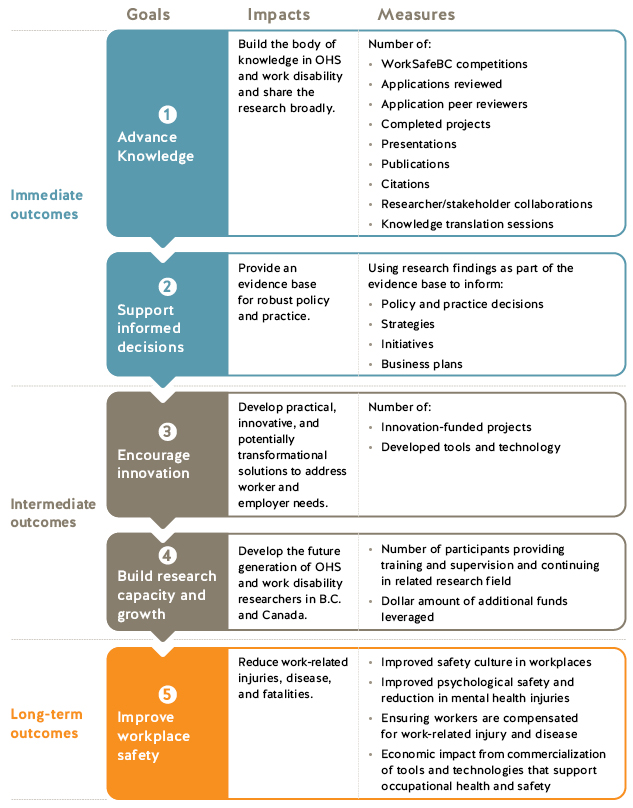Research to Action
We developed the Research to Action Framework to measure the outcomes of research funded by our Research Grants Program.
Research Grants Program
Our Research Grants Program was established in 1999 to strengthen WorkSafeBC’s commitment to occupational health and safety (OHS) research and the transfer of research knowledge to serve our stakeholders. Research funded through the Research Grants Program provides insights and solutions for OHS issues faced by workers, employers, and workplaces.
The main goals of the Research Grants Program are to:
- Advance knowledge: Build the body of knowledge in OHS and work disability and share the research broadly.
- Support informed decisions: Provide an evidence base for robust policy and practice.
- Encourage innovation: Develop practical, innovative, and potentially transformational solutions to address the needs of workers and employers.
- Build research capacity and growth: Develop the future generation of OHS and work disability researchers in B.C. and Canada.
- Improve workplace safety: Reduce work-related injuries, disease, and fatalities.
Research to Action Framework
Measuring the impact of funded research is complex, non-linear, and unpredictable. The full benefits, including policy or societal changes, can take as long as 15 years to realize. Therefore, researchers and research funders generally use easy-to-measure indicators, like the number of publications, applications received, or grants awarded.
While these measures are valuable and show research productivity, we were interested in expanding our understanding of the complex and broader impacts of our Research Grants Program.
To support this, WorkSafeBC developed the Research to Action Framework (Framework) in 2023. The Framework helps us better understand and measure the immediate, intermediate, and long-term outcomes and impacts of the Research Grants Program. It was developed using the criteria developed and used by the Institute for Work and Health, Canadian Institutes of Health Research, Canadian Academy of Health Sciences, and the US National Institute for Occupational Safety & Health. The Framework also guides how we track, measure progress, and report on the impacts of our funded research.
The Framework looks at outcomes over multiple time periods:
- Immediate outcomes are countable measures and refer to the initial, direct effects immediately or shortly after a research action. They demonstrate our ability to measure the growth and dissemination of OHS and work disability knowledge, as well as the application of that knowledge by WorkSafeBC and other organizations to support evidence-based decisions.
- Intermediate outcomes are results in the medium term, often building on immediate outcomes. They highlight the change or progress seen and contribute to the broader aims of the Research Grants Program. This includes our ability to measure the development of practical and innovative solutions to address worker and employer needs, and the development of the future generation of OHS and work disability researchers in B.C. and Canada.
- Long-term outcomes include the indirect impacts of research that will show up over an extended period. These outcomes reflect the overarching goal of the Research Grants Program — to support the workers of British Columbia and promote transformational occupational health and safety changes in workplaces and industry sectors. Additionally, these outcomes often focus on broader changes in society, organizations, and systems that are cumulative, with benefits beyond WorkSafeBC and workplaces.
The graphic below highlights the key measures used to assess the impact of the Research Grants Program, using the Research to Action Framework.
Research to Action Framework

